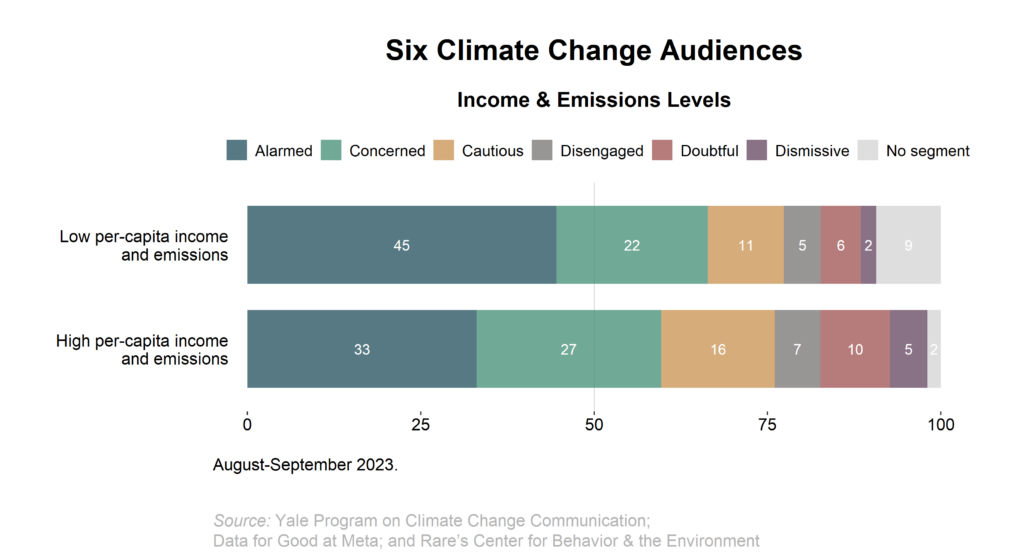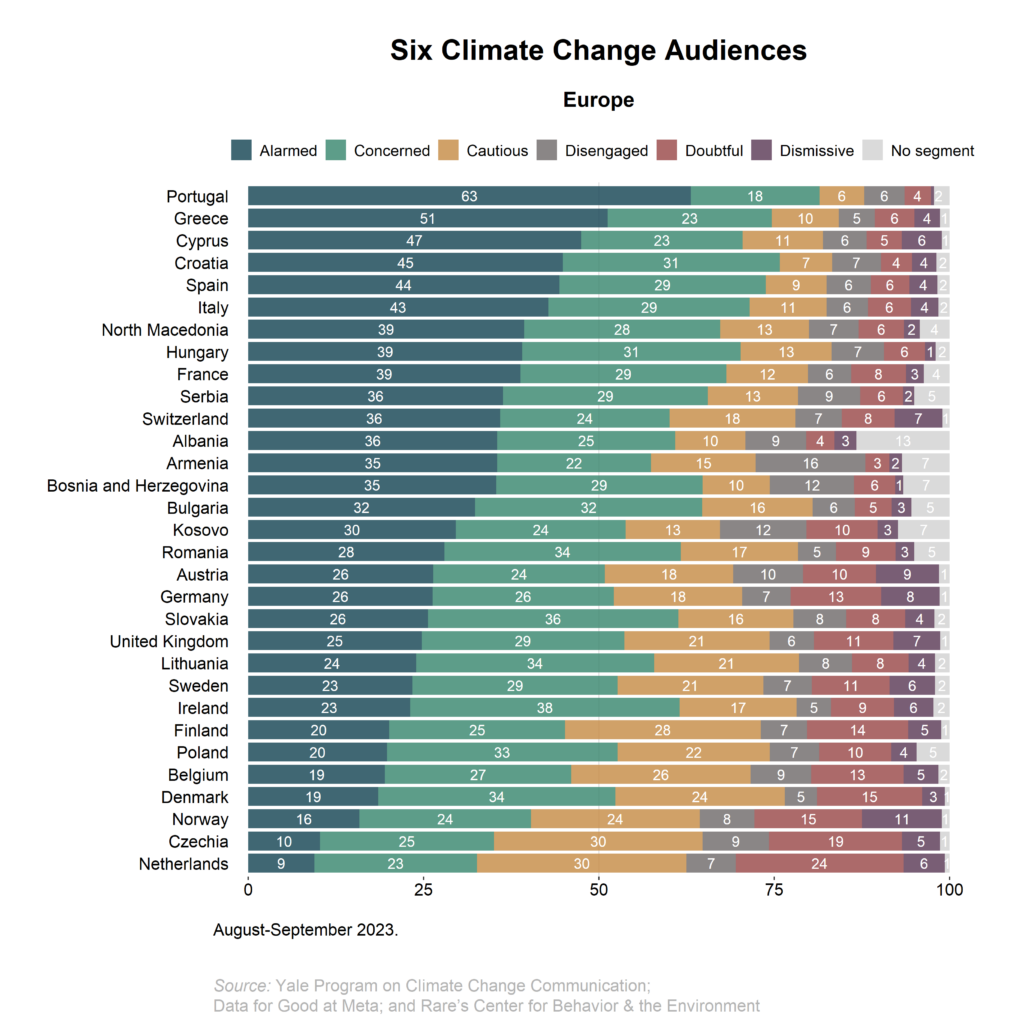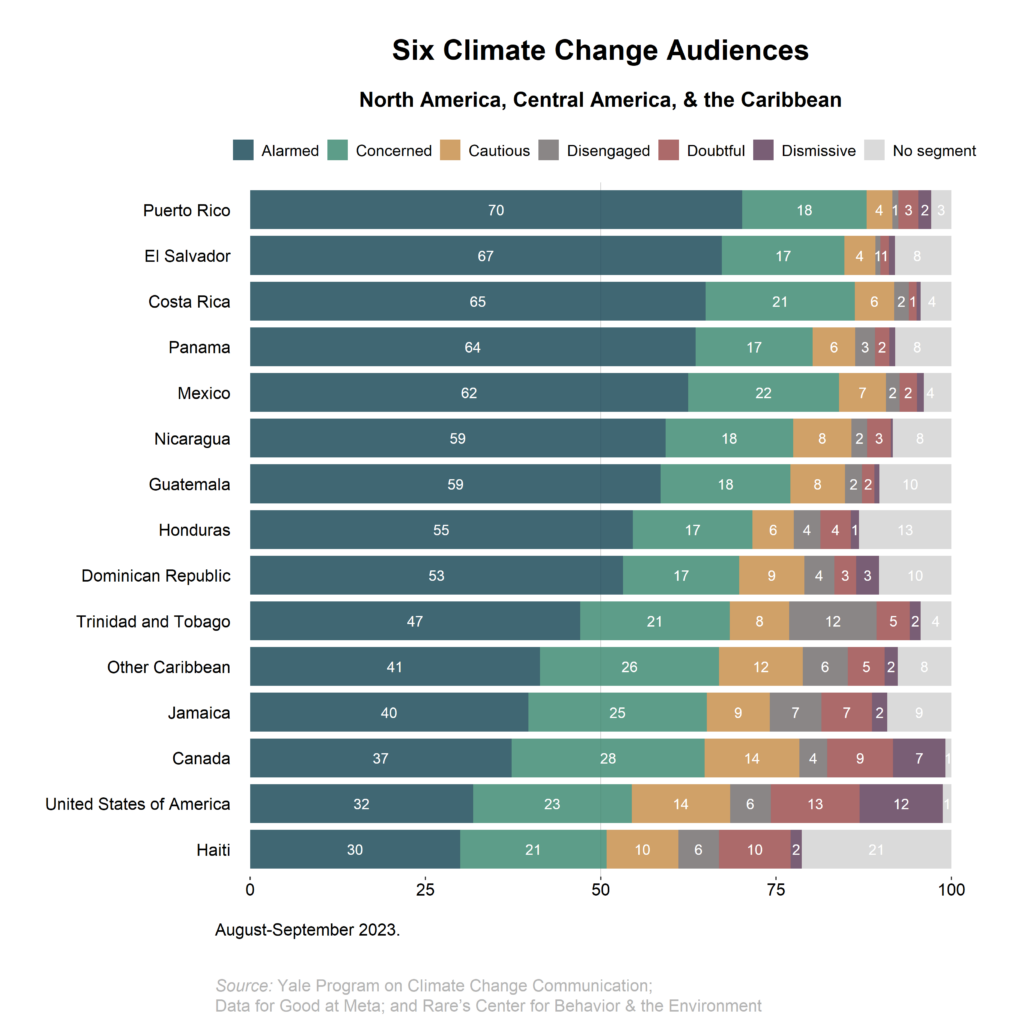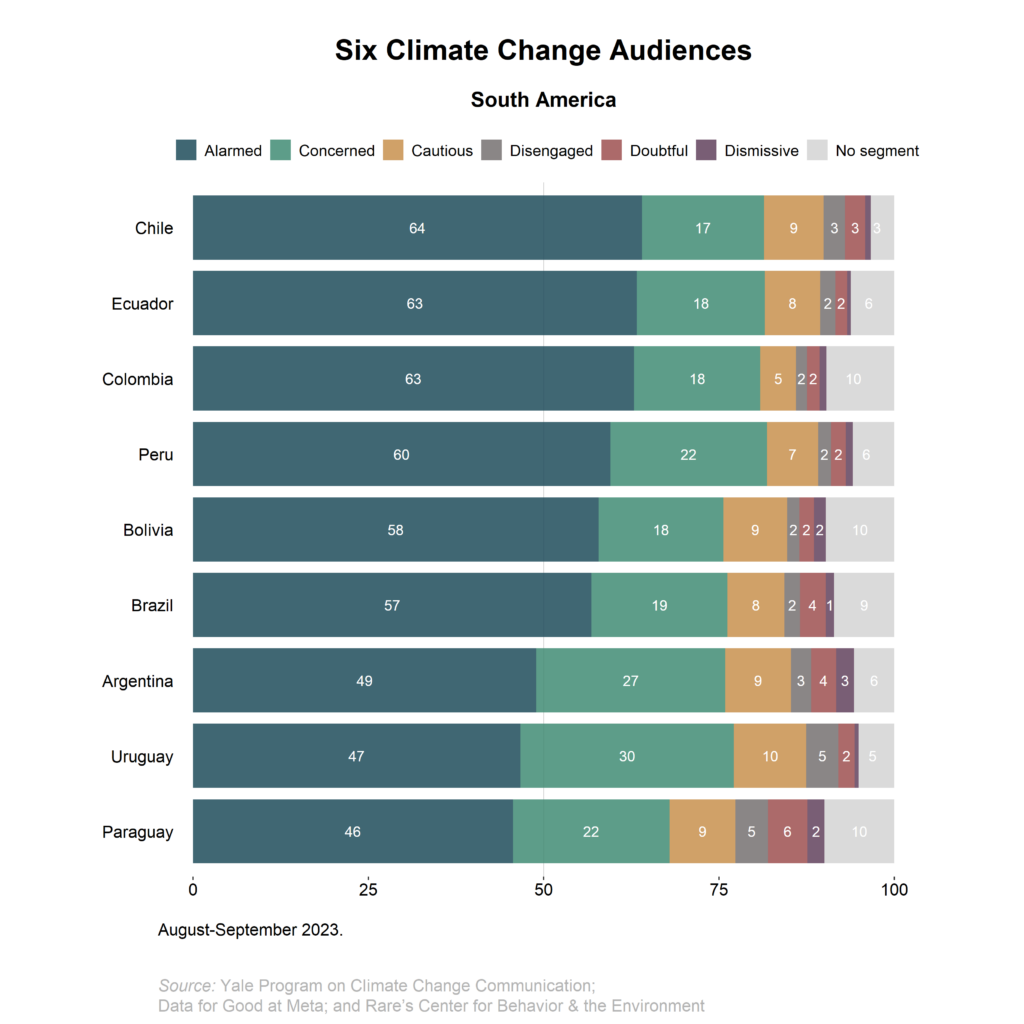Climate Note · Jul 23, 2024
Global Warming’s Six Audiences around the world
By Jennifer Carman, Marija Verner, Seth Rosenthal, Matthew Ballew, Anthony Leiserowitz, Emily Wood, Erik Thulin, Natalia Ordaz Reynoso, Jennifer Marlon and Nicole Buttermore
Filed under: Audiences and Beliefs & Attitudes

Our prior research has identified six distinct audiences within the public – the Alarmed, Concerned, Cautious, Disengaged, Doubtful, and Dismissive – based on their beliefs and attitudes about climate change. The Alarmed are convinced climate change is happening, human-caused, and an urgent threat, and strongly support climate policies. The Concerned think human-caused climate change is happening and is a serious threat, and support climate policies. However, they tend to believe that climate impacts are still distant in time and space, thus the issue remains a lower priority. The Cautious have not yet made up their minds: Is climate change happening? Is it human-caused? Is it serious? The Disengaged know little to nothing about climate change and rarely if ever hear about it. The Doubtful do not think climate change is happening or they believe it is just a natural cycle. And the Dismissive are convinced climate change is not happening, human-caused, or a threat, and oppose most climate policies.
Here, we apply this analysis to our large international survey of more than 100 countries and territories worldwide, collected in partnership with Data for Good at Meta and Rare’s Center for Behavior and the Environment in 2023. We find that the Alarmed are the largest group in about three-fourths of the areas surveyed (87 of the 110). In fact, half or more respondents in thirty-one areas are Alarmed. The five areas with the largest percentage of Alarmed are Puerto Rico (70%), El Salvador (67%), Costa Rica (65%), Chile (64%), and Panama (64%). By contrast, Czechia (10%) and the Netherlands (9%) have the smallest percentages of Alarmed. In the United States, about one-third of respondents are Alarmed (32%). Among all areas, the Netherlands has the highest proportion of Doubtful and Dismissive (30%), followed by Norway (27%) and Libya (25%). In the United States, about one in four respondents are Doubtful or Dismissive (25%).
The United States is less Alarmed about global warming than most other top carbon-emitting countries
There are substantial differences among the 15 nations in the study that are responsible for the largest annual shares of global carbon emissions (note this study did not include China, Russia, or Iran). Among these countries, the largest proportion of Alarmed are in Mexico (62%), followed by India (58%) and Brazil (57%).
The United States is the second-largest annual emitter and the world’s largest historical emitter of the carbon pollution that causes global warming. Yet, relatively few people in the United States are Alarmed about global warming, compared to other top emitters. The U.S. has the fourth-smallest percentage of Alarmed (32%), after Australia (28%), Germany (26%), and Indonesia (25%). On the other end of the Six Audiences spectrum, the countries with the largest percentages of Doubtful or Dismissive respondents are the United States (25%), Australia (24%), and Germany (21%).
The Six Audiences by Emissions & Income Level
The countries were also grouped based on whether they were below or above the global average in their per-capita carbon dioxide (CO2) emissions and income (see Methods). Notably, some countries with high overall emissions – such as India – have lower per-capita emissions due to large population sizes. Thirty-seven areas were classified as high emissions and income, and 150 areas were classified as low emissions and income.
Overall, respondents in low per-capita emissions and income areas are more likely to be Alarmed (45%) than those in high per-capita emissions and income areas (33%), and respondents in high per-capita emissions and income areas are more likely to be Doubtful or Dismissive (15%) than those in low per-capita and emissions areas (8%).
The Six Audiences by Region
Among countries and territories in Asia and the Pacific, Cambodia and Nepal have the largest proportion of Alarmed (both 60%), while Indonesia has the smallest (25%). Australia and New Zealand have the largest proportions of Doubtful or Dismissive respondents, at 24% and 19% respectively.
In Europe, Portugal has the largest proportion of Alarmed (63%), while the Netherlands has the smallest (9%). Most countries in this region have over 10% of respondents who are Doubtful or Dismissive, with especially large proportions in the Netherlands (30%), Norway (27%), Czechia (24%), and Germany (21%).
Puerto Rico has the largest percentage of Alarmed respondents in the North America, Central America, & Caribbean region (70%), and it is the area with the highest percentage globally. Majorities of respondents are also Alarmed in El Salvador (67%), Costa Rica (65%), Panama (64%), Mexico (62%), Nicaragua (59%), Guatemala (59%), Honduras (55%), and the Dominican Republic (53%). By contrast, Haiti has the smallest percentage of Alarmed respondents in North America (30%). Countries with the largest proportions of Doubtful or Dismissive respondents are the United States (25%), Canada (17%), and Haiti (12%).
Compared to other regions, South America has the greatest proportion of areas (6 out of 9) with a majority of Alarmed respondents. Chile has the largest proportion of Alarmed respondents (64%), while Paraguay has the smallest (46%). Very few people in South America are either Doubtful or Dismissive (8% or fewer in all countries).
In the region of Southwest Asia and North Africa, Turkey is the only area where a majority of respondents are Alarmed (53%). In contrast, only 15% of respondents in Yemen are Alarmed. Most countries and territories in this region have over 10% of respondents who are Doubtful or Dismissive, with especially large percentages in Libya (25%), Yemen (24%), and Jordan (20%).
In Sub-Saharan Africa, Malawi has the largest percentage of Alarmed respondents (60%). Conversely, Nigeria – Africa’s top oil producer – has the smallest proportion of Alarmed respondents, roughly one in three (32%). Areas with the largest proportions of Doubtful or Dismissive respondents are the Democratic Republic of Congo (14%) and Nigeria (12%).
Methods
The data in this report are based on a survey of 139,136 Facebook monthly active users, aged 18 and older, conducted in collaboration with Data for Good at Meta and Rare’s Center for Behavior and the Environment. The survey was conducted from August 3 – September 3, 2023. Sampled Facebook users received an invitation to answer a short survey at the top of their Facebook News Feed and had the option to click the invitation to complete the survey on the Facebook platform.
Audience segmentation is based on the Six Americas Super Short Survey (SASSY), a four-question online questionnaire that allows respondents to identify which segment they belong to (Chryst et al., 2018). Only respondents who answered all four questions were assigned a segment: if they skipped any of the four questions, they were assigned to the “no segment” group.
Ideally, one would conduct an in-depth study to develop a tailored segmentation of climate change audiences within each country, and we have previously reported tailored audience segmentations for a number of countries which identified different numbers of segments (e.g., Global Warming’s Four Indias and Climate Change’s Four Irelands). However, these studies were based on in-depth, nationally representative surveys using different interviewing and segmentation methodologies. However, the Six Audiences framework and SASSY tool can be used as a simple means of cross-national comparison using an identical set of questions that are relevant in all national contexts.
Additionally, note that these questions were asked after respondents were provided with a short description explaining what climate change is, because substantial proportions of people (especially in lower-income nations) have never heard of it.
The selection of the top 15 emitters was based on World Bank data on total greenhouse gas emissions in 2020, which is the most recent year for which data is available. Our analysis excludes China, Russia, and Iran, as no survey data were collected from these countries.
The groupings of countries and territories based on per-capita emissions and income are based on (1) being above or below global average per-capita emissions (4.4 tons CO2e) and (2) having GNI per-capita that is above or below the World Bank’s criterion for a classification of “high income” (i.e., less than $12,535 USD). The complete list of countries and territories that are classified as high-emissions/income are provided here, and the complete list of countries and territories that are classified as low-income/emissions are provided here.







